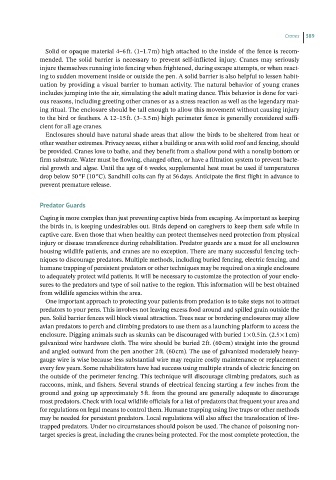Page 397 - Hand rearing birds second
P. 397
Cranes 389
Solid or opaque material 4–6 ft. (1–1.7 m) high attached to the inside of the fence is recom-
mended. The solid barrier is necessary to prevent self-inflicted injury. Cranes may seriously
injure themselves running into fencing when frightened, during escape attempts, or when react-
ing to sudden movement inside or outside the pen. A solid barrier is also helpful to lessen habit-
uation by providing a visual barrier to human activity. The natural behavior of young cranes
includes jumping into the air, simulating the adult mating dance. This behavior is done for vari-
ous reasons, including greeting other cranes or as a stress reaction as well as the legendary mat-
ing ritual. The enclosure should be tall enough to allow this movement without causing injury
to the bird or feathers. A 12–15 ft. (3–3.5 m) high perimeter fence is generally considered suffi-
cient for all age cranes.
Enclosures should have natural shade areas that allow the birds to be sheltered from heat or
other weather extremes. Privacy areas, either a building or area with solid roof and fencing, should
be provided. Cranes love to bathe, and they benefit from a shallow pond with a nonslip bottom or
firm substrate. Water must be flowing, changed often, or have a filtration system to prevent bacte-
rial growth and algae. Until the age of 6 weeks, supplemental heat must be used if temperatures
drop below 50 °F (10 °C). Sandhill colts can fly at 56 days. Anticipate the first flight in advance to
prevent premature release.
PredatorGuards
Caging is more complex than just preventing captive birds from escaping. As important as keeping
the birds in, is keeping undesirables out. Birds depend on caregivers to keep them safe while in
captive care. Even those that when healthy can protect themselves need protection from physical
injury or disease transference during rehabilitation. Predator guards are a must for all enclosures
housing wildlife patients, and cranes are no exception. There are many successful fencing tech-
niques to discourage predators. Multiple methods, including buried fencing, electric fencing, and
humane trapping of persistent predators or other techniques may be required on a single enclosure
to adequately protect wild patients. It will be necessary to customize the protection of your enclo-
sures to the predators and type of soil native to the region. This information will be best obtained
from wildlife agencies within the area.
One important approach to protecting your patients from predation is to take steps not to attract
predators to your pens. This involves not leaving excess food around and spilled grain outside the
pen. Solid barrier fences will block visual attraction. Trees near or bordering enclosures may allow
avian predators to perch and climbing predators to use them as a launching platform to access the
enclosure. Digging animals such as skunks can be discouraged with buried 1 × 0.5 in. (2.5 × 1 cm)
galvanized wire hardware cloth. The wire should be buried 2 ft. (60 cm) straight into the ground
and angled outward from the pen another 2 ft. (60 cm). The use of galvanized moderately heavy-
gauge wire is wise because less substantial wire may require costly maintenance or replacement
every few years. Some rehabilitators have had success using multiple strands of electric fencing on
the outside of the perimeter fencing. This technique will discourage climbing predators, such as
raccoons, mink, and fishers. Several strands of electrical fencing starting a few inches from the
ground and going up approximately 5 ft. from the ground are generally adequate to discourage
most predators. Check with local wildlife officials for a list of predators that frequent your area and
for regulations on legal means to control them. Humane trapping using live traps or other methods
may be needed for persistent predators. Local regulations will also affect the translocation of live-
trapped predators. Under no circumstances should poison be used. The chance of poisoning non-
target species is great, including the cranes being protected. For the most complete protection, the

